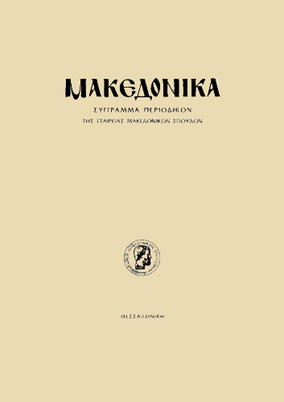Δύο παλαιοχριστιανικοί τάφοι από το Δυτικό νεκροταφείο της Θεσσαλονίκης
Part of : Μακεδονικά ; Vol.21, 1981, pages 373-389
Issue:
Pages:
373-389
Parallel Title:
Two Early Christian Tombs from the Western Cemetery of Thessaloniki
Section Title:
Articles
Abstract:
During the years 1976-77, a series of tombs was discovered in the area of the western cemetery of Thessaloniki, outside the city walls, near the Letaian Gate. Among these tombs, two were most outstanding because of their note worthy decoration. One tomb was found at 8 Agiou Nestoros Street and the other at 18 Apolloniados Street.1. The Tomb at 8 Agiou Nestoros StreetIt is an hypogeum with a rectangular vaulted chamber. Into it leads a small passage of steps. Underneath the floor of the chamber are two boxchaped tombs, which are covered by marble slabs and contain remains of more than one burials.The interior of the chamber is decorated with frescoes of flowers, fruits, birds holding a garland and a maritime scene in which a nude man is sailing amongst a great variety of fish. This animal and vegetable decoration was combined with a band which imitated marble revetment (Inkrustationsstil).Although these subjects do not have a clearly defined Christian character at first, an allegorical interpretation within the spirit of the new religion seems quite plausible.The construction and decoration of the tomb can be placed at the 2nd half of the 3rd century, being determined by the architectural form of the building, the ceramic finds and the style of painting on the walls.2. The Tomb at 18 Apolloniados StreetIt is a small vaulted tomb with an opening at the west end of the vault. A large section of the narrow eastern side had been destroyed by the machinary used during digging operations for the construction of a modern building. Internally, the tomb is covered with wall paintings which were severely damaged by flooding water and sand.The wall paintings represent scenes from the Old and New Testaments. On two narrow sides the martyrdom of the first martyr Thecla and perhaps the Good Shepherd are depicted, while on each of the long sides there are two scenestne sacrifice of Abraham and Adam and Eve in Paradise on the south wall and Daniel in the den of lions and Noah with the dove on the north wall. On the lower band of the decoration there is an imitation of colored marble plaques.The entire iconographie programm of the tomb and the historical character of the biblical scenes show that its decoration could not have taken place before the edict of Mediolanon. A dating at the times of Constantine the Great or his successor Constantius II is reasonably safe. Both the monetary indications and the explanatory inscriptions accompanying the scenes defend this position. The iconography and the style of painting also correespond to this period.The wall paintings of the two tombs, which represent two different periods and artistic trends, somehow complete the limited number of early Christian wall paintings in Eastern Illyricum. They also contribute to a better understanding of painting in the early Christian period.
Subject:
Subject (LC):
Notes:
856:https://ejournals.epublishing.ekt.gr/index.php/makedonika/article/view/6002, DOI: https://doi.org/10.12681/makedonika.441
Electronic Resources:




